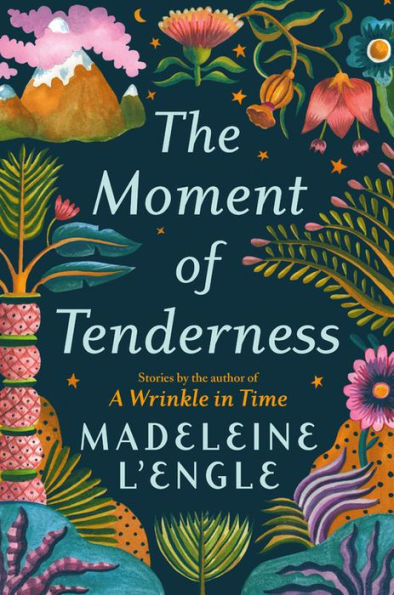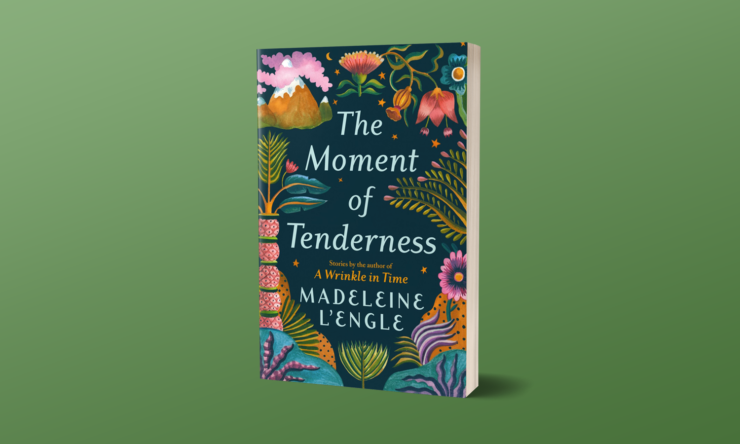So I’ve just finished reading The Moment of Tenderness, a collection of mostly unpublished stories by the late Madeleine L’Engle, and I’m not sure what to do, or what to tell you.
Let’s start, I guess, with a quick recap of Madeleine L’Engle. She’s best known for her visionary work A Wrinkle in Time, first published in 1962, and adapted twice into film. A Wrinkle in Time had four direct sequels—the equally visionary A Wind in the Door (1973), and the increasingly less visionary A Swiftly Tilting Planet (1978), Many Waters (1986) and An Acceptable Time (1989). She also wrote multiple novels for children and adults, which varied greatly in quality, and which sometimes included casual and not so casual racism, and which sometimes featured a rather alarming number of concentration camp survivors who all happened to be former members of the French Resistance or piano players or both who all happened to feel the need to remind Jews that other people, too, ended up in concentration camps.
She usually based her characters on real life people, including her family members, often to their distress. She was a victim of bullies in her earlier life, and this remained an ongoing theme in nearly everything she wrote. She was also a devout Episcopalian, incorporating those themes into her works—even as her novels were often protested by and sometimes outright banned by some Christians.
Oh, and she married a man who became a star of the popular daytime soap opera All My Children, which perhaps helps to account for the soap opera quality of some of her later adult novels.
This collection, which presents the stories more or less in the order that they were written, manages to mirror all of this. Like her novels, the stories here vary greatly in quality: some are excellent, some mediocre, one the worst story I have read in some time, enough to make me groan out loud more than once, and to cast a negative light on the entire collection. Some stories are ambiguous; some not. Some of the stories end abruptly; some linger. One story has a shock ending, all the more shocking because somehow this doesn’t seem to be that sort of short story collection. The early stories—like her early novels—often feature awkward viewpoint changes and transitions, an awkwardness that vanishes in the middle stories, only to reappear with a vengeance in the last story. Again, much like her novels. More than one story—particularly those written after her marriage—has a certain soap opera feel.
Buy the Book


The Moment of Tenderness
The stories also tend to focus on the same themes that her novels would later expand upon: bullying and peer pressure, life in the theatre, life as a working artist, irritating neighbors, religion, and, yes, in one of the earlier tales, French victims of Nazi Germany. Indeed, one story, “One Day in Spring,” (which does not feature French victims of Nazi Germany) was later reworked and expanded into a novel, The Joys of Love, which is also a way of saying, if you want to know what happens to the characters in the short story, check out the novel.
As in her novels, most of the protagonists are authorial inserts—to the point where in two of the stories narrated in the first person, the protagonist is directly called “Madeleine,” and the character’s husband is called “Hugh”—the name of L’Engle’s real life husband. And, according to L’Engle’s granddaughter (who edited the collection and wrote an introduction) most of the stories are drawn from real life—a rather startling admission given just how many of these stories focus on marital infidelity, with one even examining an open marriage.
And, as in her novels, most of the stories here are mainstream/literary, not genre. The three exceptions— “The Fact of the Matter,” a deal with the devil story of sorts which originally appeared in Marion Zimmer Bradley’s Fantasy Magazine back in 1991 (and one of the two featuring Madeleine herself as a character/narrator), “Poor Little Saturday,” an outright horror/ghost story, and “A Sign for Sparrows,” a post-apocalyptic space travel tale—all appear towards the end of the book. “Poor Little Saturday” does suggest that L’Engle might have had a career in horror, had she chosen to go that route, but otherwise, these are the hands down weakest stories in the collection.
Partly because, quite frankly, the most genuinely horrifying stories in the collection are not either of the two horror tales, but the contemporary literary ones: “The Foreigners,” the other story featuring Madeleine herself as a character/narrator in a New England village, “That Which Is Left,” a brutal story of aging and family and resentment, and “Julio at the Party,” a story of a Greenwich Village party that does not go as expected, and that’s after the innocent tropical fish die from alcohol poisoning.
“Julio at the Party” was also the one story in the collection where I honestly could not tell you what, exactly, L’Engle wanted me to think (other than, I think, feeling at least a little bit sorry for the tropical fish), but perhaps that gives the story its power. It certainly serves as the most shocking story, and one of only two stories that I wanted to talk about afterwards—but it’s also the one story best encountered without spoilers, so that’s all the discussion I can give.
They aren’t all horrifying, or gloomy—indeed, “A Room in Baltimore,” isn’t just amusing, but positively joyful, even as it provides a rather graphic illustration of difficulties of finding a hotel room that will accept dogs in the days prior to cell phones, hotel apps and GPS maps. It’s admittedly slight, especially compared to the other stories here, but a genuine delight. (Plus, cute dog.)
Which leads me, I guess, to the main question: should you read this?
Well.
Maybe?
This is where, I suppose, I should be a good little even-handed reviewer, and tell you that Madeleine L’Engle completists and diehard fans, sure, probably, maybe—but they would anyway; the function of a review like this is really just to give them something to argue over. Or perhaps, in this case, give them a chance to speculate away about what sorts of Greenwich Village parties, exactly, did L’Engle attend in those pre-A Wrinkle in Time days? Did she really consider having an affair with one of her fellow villagers? How open was she to the idea of open marriages?
Or tell you that those interested in studying the development of a writer, maybe—and I won’t deny that I took a certain comfort in watching L’Engle’s skill steadily improve through the first half of the book.
And then, maybe, note that readers may wish to know that “The Foreigners” contains some casual anti-Semitism, along with an odd insistence that the two characters coded as Jewish, with Jewish names, are not in fact Jewish, and a really odd moment of nudity that I found difficult to reconcile with my general, perhaps—probably—inaccurate of New England in the 1950s. (I’m not saying that no one ever decided to ditch clothing from time to time back then, just that this particular episode feels odd.) And that the stories contain a few other moments of casual, unthinking racism here and there that some readers might find offensive.
But this last story, “A Sign for a Sparrow.”
This last story.
Two pages in, I was rolling my eyes—tempted to showcase the story as an example of how not to do worldbuilding, an impression left unchanged by the time I reached the end. Every part of the premise—from its post-apocalyptic world, to its space trip, to the amount of and type of entertainment available on its spaceship (no excuse; this story was written after the development of the VCR and after Star Trek: The Next Generation had widely introduced the concept of unlimited virtual reality entertainment delivered by computer), to the new world the characters eventually encounter, to the “you have got to be kidding me,” final paragraph is, to put it mildly, unconvincing. To be fair, “A Sign for a Sparrow” is less story than fierce polemic about anti-Christian thought and forces (here represented by apocalypse and governments) and an argument for the universality of Christianity.
It also contains a—how to put this—interesting take on European colonization of the Americas that will offend some readers, and later offhand comments about “eastern nations” (implied to be China, Japan, India and Pakistan) that will certainly offend other readers, and other comments that may offend Christians and non-Christians alike. Also an ableist comment fairly early on that made me wince. There’s a lot of questionable stuff here, is what I’m saying; it’s a story virtually tailored to get the book banned in multiple places.
I initially planned to just leave my comments there. But as I was—very slowly—writing this review, an apocalypse of sorts actually happened, in real time. I would write a word or two here, only to find another event cancelled, or the NBA cancelled, or long-running Supernatural managing to film 15 straight seasons only to find itself halted right as it was filming its last episodes, or toilet paper vanishing from everywhere, or Disney World closing for an unprecedented two weeks, travel bans, border closings, quarantines—
Well, you know all this.
And interspersed into all of these tales: alarming stories of Chinese restaurants losing customers; Chinese and Asian supermarkets still stocked with toilet paper and hand sanitizer because people were avoiding them. A Korean friend freaking out because people had moved away from her on a bus.
And I went back to this, from “A Sign for a Sparrow”:
Aren’t we kind of hoping, in spite of all of our noble talk of the cosmic rays suddenly falling into a pattern, indicating that there may be a highly civilized race there signaling us, aren’t we still kind of hoping that if there’s any population at all it will be a backwards one and we can move in, just as the English did back in the sixteenth century?
The speaker is a Christian minister whose church has recently been shut down by the government after a nuclear war.
And:
The eastern nations who’ve always spawned more rapidly than we have are already beginning to feel the pinch. That’s why we’ve got to get in first, before anybody else does. Maybe we know enough to share. They don’t.
This speaker is a “dark skinned man” who is also the spaceship doctor.
Both the minister and the doctor are supposed to be among the good guys.
As a writer, I know how dangerous it is to assume that authors hold the same beliefs as their characters. I will not do L’Engle that disservice here, tempted though I am to do so by many comments and plots in her other books. I will not tell anyone not to read this book, or other L’Engle books.
But I will say that, intentionally or not, L’Engle did, in the middle of an otherwise just terrible story on all levels, identify one truth I am witnessing right now: sometimes, survival can uncover some very ugly things.
The Moment of Tenderness is available from Grand Central Publishing.
Mari Ness lives in central Florida.










